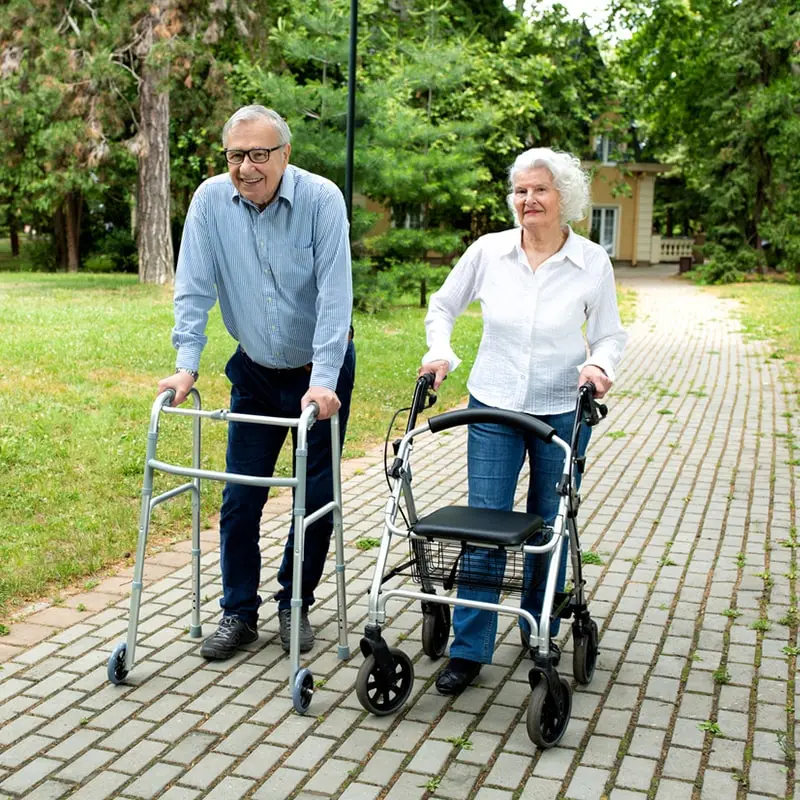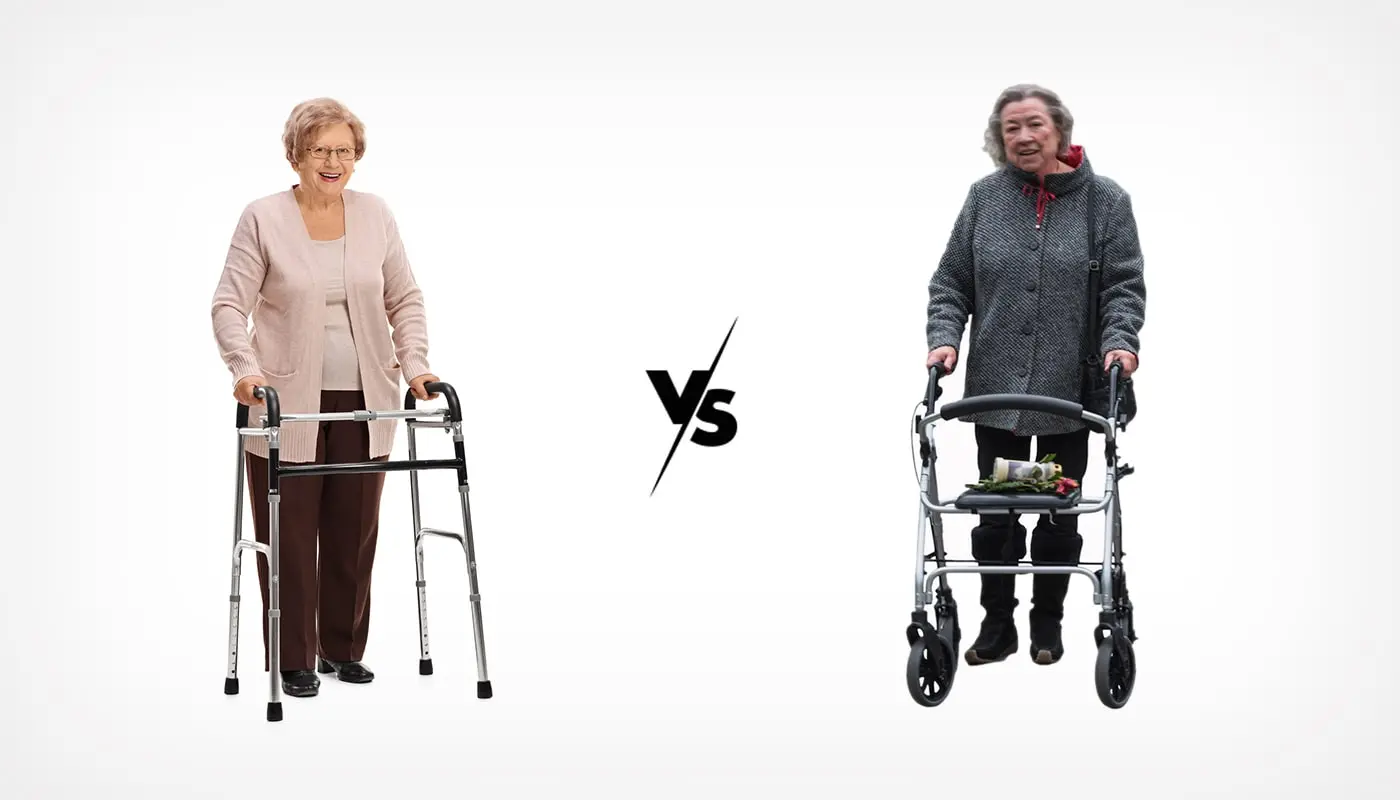Mobility can be a challenge for seniors, preventing them from doing day-to-day tasks. Even getting around the house can be difficult, let alone going out for a walk or running errands. Fortunately, there are a variety of mobility devices that can help – it’s not just walkers vs. rollators. Walkers, rollators, knee scooters, canes, wheelchairs, and hybrid walkers are all designed to provide support and make it easier to get around. Standard walkers are the simplest type of mobility device. They provide support and stability, but they do not have wheels. This means that they can be more difficult to maneuver, especially on uneven surfaces.
Rollators are similar to walkers, but they have wheels. This makes them easier to maneuver, but they can be more difficult to lift over obstacles. Hybrid walkers are a combination of the two. They have wheels for easy maneuverability, but they also have legs that can be raised and lowered to clear obstacles. No matter which type of mobility device you choose, it is important to make sure that it is the right fit for you. Seniors need support, but they also need to be able to move around easily and safely.
Independent seniors are healthier mentally and physically. With a little assistance from 1 True Health, seniors can manage their healthcare and age in place confidently.
Walkers vs. rollators: Your choices
First, let’s clear up the difference between walkers vs. rollators. All rollators are walkers, but not all walkers are rollators. Rollators have wheels on all four legs or three legs, while regular walkers only have two wheels on the front legs or no wheels at all. This makes rollators much easier to maneuver and also provides more stability. Regular walkers are best for people who don’t need as much help with balance and can lift the back legs of the walker off the ground themselves. Walkers and rollators can both come with seats, which can be very helpful for people who need to take a break while walking. No matter what type of walker you choose, it is important to make sure that it is the right size for you. Walkers that are too big or too small can be difficult to use and can actually cause more problems than they solve.
Standard walker
For those recovering from an injury or surgery, a standard walker can be a great asset. They provide support and stability while you are learning to walk upright again. They can also help you keep your balance while moving around your home. However, there are a few things to keep in mind when using a standard walker. First, make sure that the walker is the right height for you. If it is too low, you will have to stoop to use it, which can put a strain on your back. If it is too high, you may not be able to reach the handles comfortably. If you’re someone below 5’2″, short walkers for seniors would be a good choice for you. Tall walkers for seniors are also available for those above 5’11” in height. Second, pay attention to your posture while using the walker. Keeping your back straight and your shoulders relaxed will help you move more easily and avoid pain or fatigue. Finally, take your time when first learning to use the walker. Starting off slowly will help you get used to the feel of the walker and build up your strength and endurance. With a little practice, you will be able to use your walker with confidence and ease.
Two-wheel walker
A two-wheel walker is a mobility device that can be extremely helpful for those who have difficulty walking. Also known as a “rolling walker” or “rolling support walker,” this device provides additional stability and support compared to a traditional cane or walker. Two-wheel walkers typically have two large wheels in the front and no wheels in the back. This design aids in the even distribution of weight and makes it easier to maneuver over uneven surfaces. Folding designs can help with storage concerns. Additionally, most two-wheel walkers come equipped with basket or tray accessories, which can be used to carry groceries or other items. Two-wheel walkers are typically used by people who have difficulties walking without assistance, such as those with Parkinson’s disease or stroke. However, anyone who has trouble maintaining their balance may benefit from using a two-wheel walker.
Three-wheel walker/rollator
A three-wheel walker, also known as a rollator, is a mobility device that can be extremely helpful for those who have difficulty walking and do not have enough strength to lift the walker. Unlike a four-wheel rollator, a three-wheel walker has one wheel in the front and two in the back, which makes it more maneuverable and easier to turn. Additionally, three-wheel walkers usually have brakes and seat belts, which can provide additional safety and security. For many people, a three-wheel walker can help to increase independence and confidence when walking. If you or someone you know is struggling with mobility, consider investing in a three-wheel walker. With its many benefits, a three-wheel walker just might be the perfect solution.
Four-wheel walker/rollator
For those of us who enjoy the outdoors, a four-wheel rollator can be a wonderful tool that allows us to get around easily and safely and maintain overall health. These devices have four large wheels, making them very stable and easy to maneuver. They also have brakes that can be engaged when we need to stop and rest. Most importantly, many rollators have a seat making it a great feature for seniors who may need to take frequent rests. They are also able to carry a greater weight load for those who want to take more personal items along with them. Walkers and rollators are available in different sizes, and with different accessories and features including some folding options, so it is important to choose one that is right for you to keep you upright and moving.
Knee scooters
If you or a loved one are having difficulty getting around due to an injury, a knee walker or rollator, also called knee scooters, can be a helpful solution and avoid the use of wheelchairs. These walking aids provide support and stability, making it easier to walk without pain. Knee walkers are typically used for short-term injuries, while rollators are designed for longer-term use. Both types of devices have four wheels and can be steered with handlebars. Knee walkers also have a padded knee rest, which allows you to rest your injured leg while still being able to move around upright. Knee rollators often have features and accessories such as brakes, storage baskets, and built-in seats, which make them ideal for everyday use. If you’re not sure which type of device is right for you, consult with your doctor or physiotherapist. With the help of knee scooters, patients can be back in better health and on their feet faster.
Seniors and caregivers face healthcare-related challenges every day, but our Care Navigators can provide peace of mind by providing trustworthy and knowledgeable assistance.
Walkers vs. rollators: Walker pros and cons
A walker is a great option for people who are looking for a little bit of help when it comes to getting around. Walkers can provide support and stability, making it easier to stay upright and regain your balance if you stumble. Walkers can also help you to keep up your pace if you get tired, and they can also be used as a seat if you need to take a break if they have a seat accessory. However, walkers can also be difficult to maneuver, and they may not be suitable for everyone. If you have limited mobility in your hands or arms, then a walker may not be the best option for you. In addition, walkers can be bulky and difficult to store, so they may not be ideal if you live in a small space. Ultimately, whether or not a walker is right for you is a personal decision. If you think that a walker could improve your quality of life, then it is definitely worth giving one a try. Walkers come in different types, styles, and sizes. There are narrow walkers for seniors, which help them get around in tiny spaces. There are bariatric and wide walkers for seniors for those who need extra room to stay upright.
Walkers are available in a variety of sizes and styles, so it’s important to choose one that best suits your needs. Walkers with four legs without wheels are more stable and provide more support, while two-wheeled walkers are more maneuverable but may not be as stable. If you have more severe mobility issues, a three-wheeled walker might be the best option. Walkers are also ideal for people recovering from surgery or who have lower body weakness and want additional support when walking. In addition to the general physiological effects of using a walker, such as increased muscle strength and improved cardiovascular fitness, there are also psychological health benefits. Using a walker can help you feel more confident and independent, and it can also lead to a better social life as you interact with other people who use walkers. Finally, using a walker can decrease the burden of care for family and friends who may otherwise need to help you with everyday tasks.
Walkers vs. rollators: Rollator pros and cons
Walkers vs. rollators: Which is the better option for you?
When it comes to mobility aids, there is no one-size-fits-all solution. Depending on your individual needs, you may find that a rollator or a walker is better suited to your lifestyle. If you have difficulty walking long distances, a rollator can be a great option. This type of mobility aid provides a seat for resting, as well as storage space for carrying any belongings you may need while out and about. In addition, the built-in brakes provide extra safety and security. However, if you need more stability and support, especially when moving from sitting to standing, a traditional walker may be a better choice. Walkers are designed to provide maximum stability, and they can be equipped with additional features such as handrails or wheels. Avoiding wheelchairs is a common goal among seniors and their caregivers, but sometimes a walker or rollator is not enough and wheelchairs are the right choice. Ultimately, the best mobility aid for you is the one that meets your specific needs and health requirements.
Take your first step to 1 True Health
Among the many great things about walkers for seniors is that they offer the ease and security that you need to navigate your environment with confidence. This allows you to continue to live a fulfilling, active lifestyle without sacrificing independence and security. Walkers help you stay upright and in control of the things that happen in your life, whether you are out for a stroll by the ocean or just going around your neighborhood. Therefore, if you are looking for a walker or a rollator that can keep you on the go without compromising your independence, then you just may be on your way to staying active and engaged.

